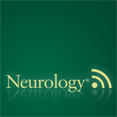
Stroke Prognostication using Age and NIH Stroke Scale: SPAN-100
![]() When applied to the National Institute of Neurological Disorders and Stroke
tissue plasminogen activator (tPA) trial data, the combination of age plus
NIH Stroke Scale score (SPAN-100) was associated with higher risk of
intracerebral hemorrhage in SPAN-100–positive (score greater than or equal to 100) patients,
whether receiving tPA or not, compared to SPAN-100–negative patients.
The benefit of tPA was apparent in the SPAN-100–positive group, but not
in the SPAN-100–negative group. See p. 21
From editorialists Rabinstein and Rundek: Should any score predicting very
poor outcome despite thrombolysis, or a high risk of hemorrhage with
thrombolysis, be deemed sufficient to withhold IV tPA administration. See p. 15
When applied to the National Institute of Neurological Disorders and Stroke
tissue plasminogen activator (tPA) trial data, the combination of age plus
NIH Stroke Scale score (SPAN-100) was associated with higher risk of
intracerebral hemorrhage in SPAN-100–positive (score greater than or equal to 100) patients,
whether receiving tPA or not, compared to SPAN-100–negative patients.
The benefit of tPA was apparent in the SPAN-100–positive group, but not
in the SPAN-100–negative group. See p. 21
From editorialists Rabinstein and Rundek: Should any score predicting very
poor outcome despite thrombolysis, or a high risk of hemorrhage with
thrombolysis, be deemed sufficient to withhold IV tPA administration. See p. 15
Serial proton MR spectroscopy of gray and white matter in relapsing-remitting MS Eighteen recently diagnosed, mildly disabled patients, all on immunomodulatory medication, were scanned semiannually for 3 years with T1- and T2-weighted MRI and 3D proton magnetic resonance spectroscopic imaging at 3 T, with 10 controls followed annually. Diffuse white matter glial abnormalities were larger than the axonal abnormalities and increased over time despite immunomodulatory treatment. See p. 39; Editorial p. 17
Active MS is associated with accelerated retinal ganglion cell/inner
plexiform layer thinning
![]() One hundred sixty-four patients with multiple sclerosis (MS) and 59
controls underwent spectral-domain optical coherence tomography
scans every 6 months for a period of 21.1 months. Patients developing
optic neuritis were excluded from analysis. MS patients with clinical
and radiologic nonocular disease activity early in the disease course
exhibited accelerated ganglion cell/inner plexiform thinning. See p. 47; Editorial p. 19
One hundred sixty-four patients with multiple sclerosis (MS) and 59
controls underwent spectral-domain optical coherence tomography
scans every 6 months for a period of 21.1 months. Patients developing
optic neuritis were excluded from analysis. MS patients with clinical
and radiologic nonocular disease activity early in the disease course
exhibited accelerated ganglion cell/inner plexiform thinning. See p. 47; Editorial p. 19
Clinical relevance of differential lymphocyte recovery after
alemtuzumab therapy for multiple sclerosis
![]() Fifty-six patients were followed for 39.5 months post alemtuzumab
treatment with interval clinical assessments, lymphocyte
immunophenotyping, and MRI. Timing and degree of lymphocyte recovery
were correlated with the re-emergence of disease activity, with new disease
activity recorded in14%of patients. Differential lymphocyte reconstitution
after alemtuzumab treatment may be a biomarker for relapse. See p. 55
Fifty-six patients were followed for 39.5 months post alemtuzumab
treatment with interval clinical assessments, lymphocyte
immunophenotyping, and MRI. Timing and degree of lymphocyte recovery
were correlated with the re-emergence of disease activity, with new disease
activity recorded in14%of patients. Differential lymphocyte reconstitution
after alemtuzumab treatment may be a biomarker for relapse. See p. 55
Spinal cord lesions in patients with clinically isolated syndrome:
A powerful tool in diagnosis and prognosis
![]() The authors followed 121 monofocal, relapsing onset clinically isolated
syndrome (CIS) patients with either spinal cord (SC, n 5 63) or brain
symptom onset. MRI of the brain and SC were performed shortly after
onset with patients followed for 24 to 119 months. Presence of SC
lesions was predictive for conversion to clinically definite MS,
especially in patients with nonspinal CIS who did not fulfill MRI criteria. See p. 69
The authors followed 121 monofocal, relapsing onset clinically isolated
syndrome (CIS) patients with either spinal cord (SC, n 5 63) or brain
symptom onset. MRI of the brain and SC were performed shortly after
onset with patients followed for 24 to 119 months. Presence of SC
lesions was predictive for conversion to clinically definite MS,
especially in patients with nonspinal CIS who did not fulfill MRI criteria. See p. 69
Temporal discrimination in patients with dystonia and tremor and patients with essential tremor Somatosensory temporal discrimination thresholds (TDT) and temporal discrimination movement thresholds (TDMT) were tested in 39 patients with either tremor associated with dystonia or essential tremor presenting with upper-limb tremor; findings were compared with 25 controls. TDT and TDMT testing may be useful for differentiating tremor associated with dystonia and essential tremor. See p. 76
Amyloid is linked to cognitive decline in patients with Parkinson disease without dementia This study examined 46 patients with Parkinson disease (PD) without dementia, of whom 35 had normal cognition and 11 met criteria for PD with mild cognitive impairment at baseline. At baseline measurements, amyloid burden did not distinguish between cognitively impaired and unimpaired patients with PD without dementia, but the study suggests that amyloid contributes to cognitive decline over time. See p. 85
High risk of severe cardiac adverse events in patients with mitochondrial m.3243A>G mutation The authors identified 41 patients carrying the m.3243A.G mutation, of whom 38 had clinical manifestations of mitochondrial encephalomyopathy, lactic acidosis, and stroke-like episodes and 3 were asymptomatic. Patients with the m.3243A.G mutation had a high incidence of cardiac death and life-threatening adverse events. Left ventricular hypertrophy was the only measure independently associated with occurrence of these events. See p. 100
NB:Dreams/explorations, p. 121. To check out other Visions, point your browser to www.neurology.org.
See future Table of Contents
- Advertisement




